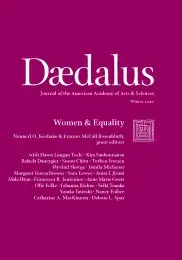Sexual Harassment of Women Leaders
Sexual harassment is more prevalent for women supervisors than for women employees. This pattern holds in the three countries we studied–the United States, Japan, and Sweden–where women supervisors are between 30 to 100 percent more likely to have been sexually harassed in the last twelve months. Among supervisors, the risk is larger in lower- and mid-level positions of leadership and when subordinates are mostly male. We also find that harassment of women supervisors happens despite their greater likelihood of taking action against the abuser, and that supervisors face more professional and social retaliation after their harassment experience. We conclude that sexual harassment is a workplace hazard that raises the costs for women to pursue leadership ambitions and, in turn, reinforces gender gaps in income, status, and voice.
Access the Web Appendix here.
Picture an incident of sexual harassment. For many, this prompt brings up the image of the boss of a firm harassing his secretary. Pioneering research on sexual harassment in the 1970s was focused on exactly this type of scenario.1 Women were harassed at the job while doing “womanly” things like cleaning up the office or assisting with meetings: essentially a wife’s tasks, but in the workplace.2 The power component was also clear. Men with power harassed women without power.
Much has changed since the 1970s. Women are no longer relegated to the lowliest positions in the corporate hierarchy. Nor are they restricted to administrative roles, but have moved into positions of leadership. A “silent revolution” has shaken the labor market, with large increases in women’s labor force participation and many women starting to see career ambition as part of their identity.3 More women have been advancing to positions of organizational leadership, reducing the power gap with men in the workplace.
Recent research has highlighted how women’s advancement may involve a “paradox of power”: rather than reducing exposure to sexual harassment, power in the workplace seems to put women at greater risk. In a pathbreaking study of three hundred U.S. women in their thirties, sociologists Heather McLaughlin, Christopher Uggen, and Amy Blackstone found higher rates of harassment among women who had reached supervisory positions at this stage of their career.4
Our research in the United States, Japan, and Sweden lends support to the paradox of power hypothesis. We probe the mechanisms behind the paradox by comparing, first, if women supervisors are harassed by different types of perpetrators and, second, if supervisors take different types of action after they are harassed. We then consider the consequences of harassment and find that, in addition to the higher prevalence of harassment against them, women supervisors also seem to suffer more professional and social retaliation after their harassment experience.
Across the globe and across all sectors of society, women become scarcer on higher rungs of organizational hierarchies.5 Our study offers one reason for this baleful result: because women face increasing levels of sexual harassment as they gain workplace power. The workplace hazard of sexual harassment adds a burden for women who pursue supervisory positions, as evidenced by the hundreds of empirical studies showing that sexual harassment damages, among other things, the victim’s psychological well-being, productivity at work, and sense of belongingness in the workplace.6
The costs of growing rates of harassment for women supervisors also extend beyond the individual victim to the organization as a whole. The paradox of power means that, because sexual harassment can potentially discourage women from seeking promotion, women’s leadership talents are not realized at the same rate as men’s. Organizations are losing women’s skill and potential for these higher positions, while women are losing the wages, status, and voice in society that such jobs can bring.
We begin with a look at our data sources and measurements of sexual harassment. The Swedish data come from the Work Environment Survey, a biannual survey collected by the Swedish government.7 This survey uses a random sample of the employed population of permanent residents, stratified by sex at birth, age, occupation, industry, and social class. We use five waves of this survey (1999–2007), each one with roughly five thousand women respondents. These respondents were fully anonymous and their workplaces were not aware that they were being surveyed. The survey contains more than one hundred questions on various aspects of working environments, meaning that the ones on sexual harassment are unlikely to stand out to the respondent. There are 23,994 responses for women across five pooled surveys: 1999, 2001, 2003, 2005, and 2007. Because the United States and Japan did not have comparable data, we collected original survey data in these two countries, which in turn allowed us to ask more detailed questions to understand the mechanisms of sexual harassment exposure and reporting.
For the United States, we surveyed a convenience sample from the online panel of the survey company Dynata in June 2019. We oversampled employed women and women with management positions for a total final sample size of 1,261. We added a survey question to check the attentiveness of respondents, which was answered correctly by 848 persons. In what follows, we use the full sample. A description of the age, education, income, and marital status of the respondents can also be found in the Web Appendix for all three countries (Table W1) and for attentive and nonattentive respondents of Japan and the United States (Table W2).
We surveyed employed women Japanese citizens in early 2019. The sample was drawn by the Japanese survey firm Nikkei Research from their opt-in online panel and with an oversampling of women supervisors. The survey reached 1,573 respondents, whereof 720 were attentive. We also conducted a semistructured interview with six employees (four women and two men) at a Japanese firm in March 2019 to gain better understandings of the mechanisms of sexual harassment.
The Swedish Work Environment Survey contains three questions on respondents’ experiences of sexual harassment at work over the last twelve months. These were translated from Swedish by the authors.8 We count a person as having experienced harassment if they answer affirmatively to any of these questions. Because the questions contain examples of harassing behaviors, but largely leave it to the respondent to recall things that happened to them, the resulting variable has elements of a list-based measurement, but is largely subjective.
The first two questions are formulated as follows: “In the following questions, sexual harassment is defined as unwelcome physical actions or offensive remarks or innuendos on subject matter that is commonly associated with sex.” Respondents are then asked if, in the last twelve months, they experienced these behaviors 1) from supervisors or colleagues, or 2) from other people (for example, customers, patients, clients, passengers, or students). These questions contain examples of sexual hostility as well as unwanted sexual attention.
The third question is formulated as:
Have you been exposed to behaviors other than the ones above, which degraded you or violated your integrity, and were based on your gender? This could include condescending and ridiculing statements about women or men in general or in your occupation. It could also include that someone, because of your gender, ignored you or what you were saying. Have you experienced any such harassment from colleagues or supervisors in the last twelve months?
For this question we lack information about people other than colleagues or supervisors. The question includes a typical example of sexist hostility–condescending and ridiculing comments–but also includes an example of selective incivility.9 Having your person or opinion ignored because of your gender is closer to this workplace misbehavior than to sexual harassment. The inclusion of this example (in the end of) the survey question is likely to inflate the rate of sexual harassment. There is, hence, upward bias from the inclusion of selective incivility, but downward bias from the subjectivity of the questions. Some downward bias might also stem from the lack of any example of sexual coercion in the survey questions.
For the United States and Japan, we measured sexual harassment in two ways. The first is a list-based survey question, the Sexual Experiences Questionnaire, a survey instrument that has evolved over time to capture both legal and psychological types of harassment.10 The survey presents respondents with a list of twenty-three types of behaviors and asks, “In the past 12 months, have you ever been in a work situation where one or more individuals [behaved in this way]?”11 These twenty-three items are listed in Table 1. Our measurement of list-based sexual harassment takes the value one for women who experienced any one of the twenty-three behaviors in the last twelve months, and a zero otherwise.
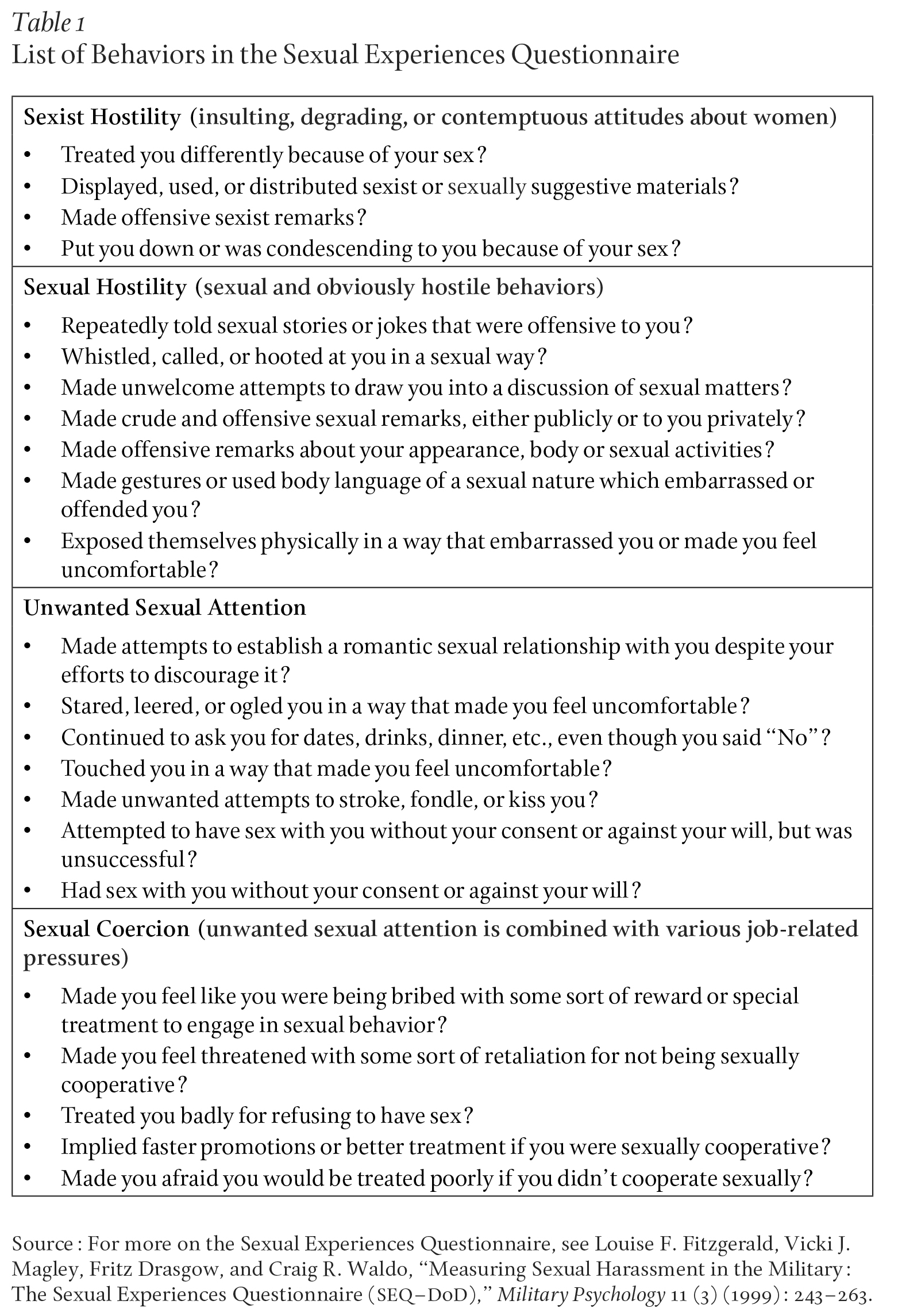
The second measurement of sexual harassment in Japan and the United States is a subjective measure. The respondent is simply asked if they were “sexually harassed” in the last twelve months. Our measurement of subjective sexual harassment takes the value one for women who answer affirmatively to this question, and zero otherwise. It is well documented that such subjective questions generate lower reported rates of sexual harassment than list-based measures. This is because respondents fail to define less severe incidents at work as sexual harassment, and hence omit less severe or frequent incidents.12
We used the same definition of supervisors in all three countries. Respondents are defined as supervisors if they reported that at least some part of their job involved “leading or delegating work for other employees.” This includes all people who supervise others, from team leaders to CEOs. The proportion of women who were supervisors was 24 percent (N=5,802) in the Swedish data. In the U.S. and Japanese data, we oversampled supervisors to increase the precision of our statistical tests. Sixty-two percent of respondents were supervisors in our U.S. data (N=782) and 17 percent were supervisors in the Japanese data (N=263). We asked survey respondents to identify their precise type of leadership position, which we return to below.
Figure 1 compares the rates of sexual harassment in the last twelve months between employees and supervisors. Across all three countries, and for both the list-based and subjective measures, we find that supervisors face much more harassment. The smallest difference is found in the Swedish case. Still, supervisors report a 30 percent higher rate of harassment (20 percent of supervisors compared with 15 percent of employees report sexual harassment in the last twelve months). In the United States, we find a 50 percent higher rate for supervisors (57 versus 37 percent) for the list-based measure, and nearly 100 percent higher for the subjective measure (30 versus 16 percent). In Japan, supervisors report a 30 percent higher rate than employees using the list-based measure (68 versus 52 percent) and, similar to the United States, almost 100 percent higher for the subjective measure (25 versus 13 percent). Table W4 in the Web Appendix breaks down women’s experiences across the four types of sexual harassment (as defined in Table 1). In both the United States and Japan, where the data allow this breakdown, women supervisors are the subjects of more harassment across all four categories. Before turning to possible explanations of these results, we further disaggregate the results by looking at differences across higher and lower positions of leadership, and across variation in the sex-compositions of subordinates.
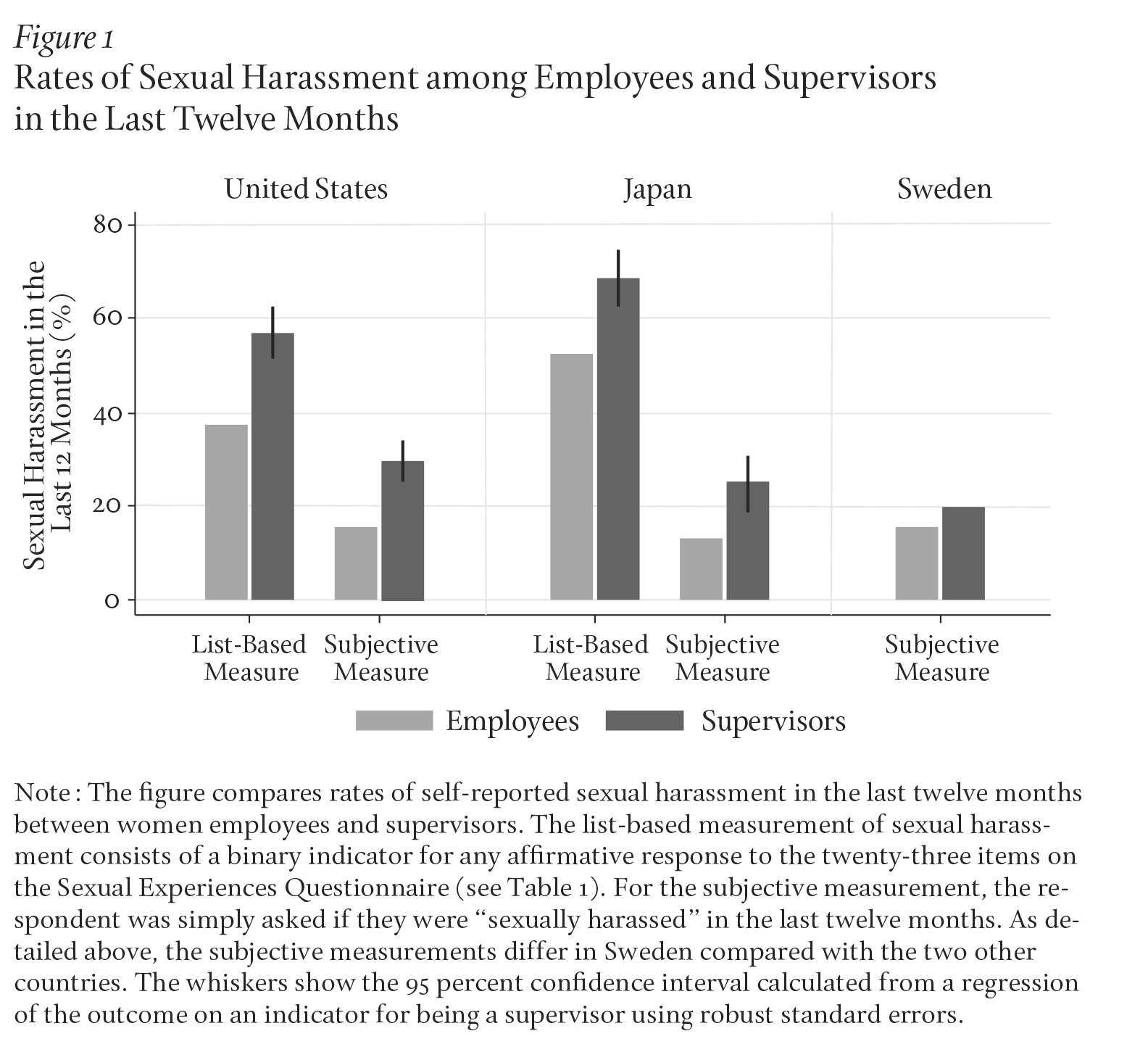
We first compare women supervisors by the sex-composition of their subordinates, divided into the three categories of “mostly male,” “mostly female,” or “about half-half.” Figure 2 shows that in all three countries, women who supervise “mostly male” subordinates face about 30 percent more sexual harassment than those with “mostly female” subordinates. One explanation for this pattern could be mechanical, where a larger number of men in a woman’s proximity is associated with a greater likelihood that at least one of them will engage in harassment. This follows from the insight that “not all men” harass women, but that the behavior rather is concentrated to a small number of people with a latent tendency to harass.13 This latent tendency is also largely unrelated to traits like income or education levels.14 With a near-random but small risk that each male subordinate has a latent tendency to harass, having more men among the subordinates will imply a higher risk of sexual harassment, all else equal.
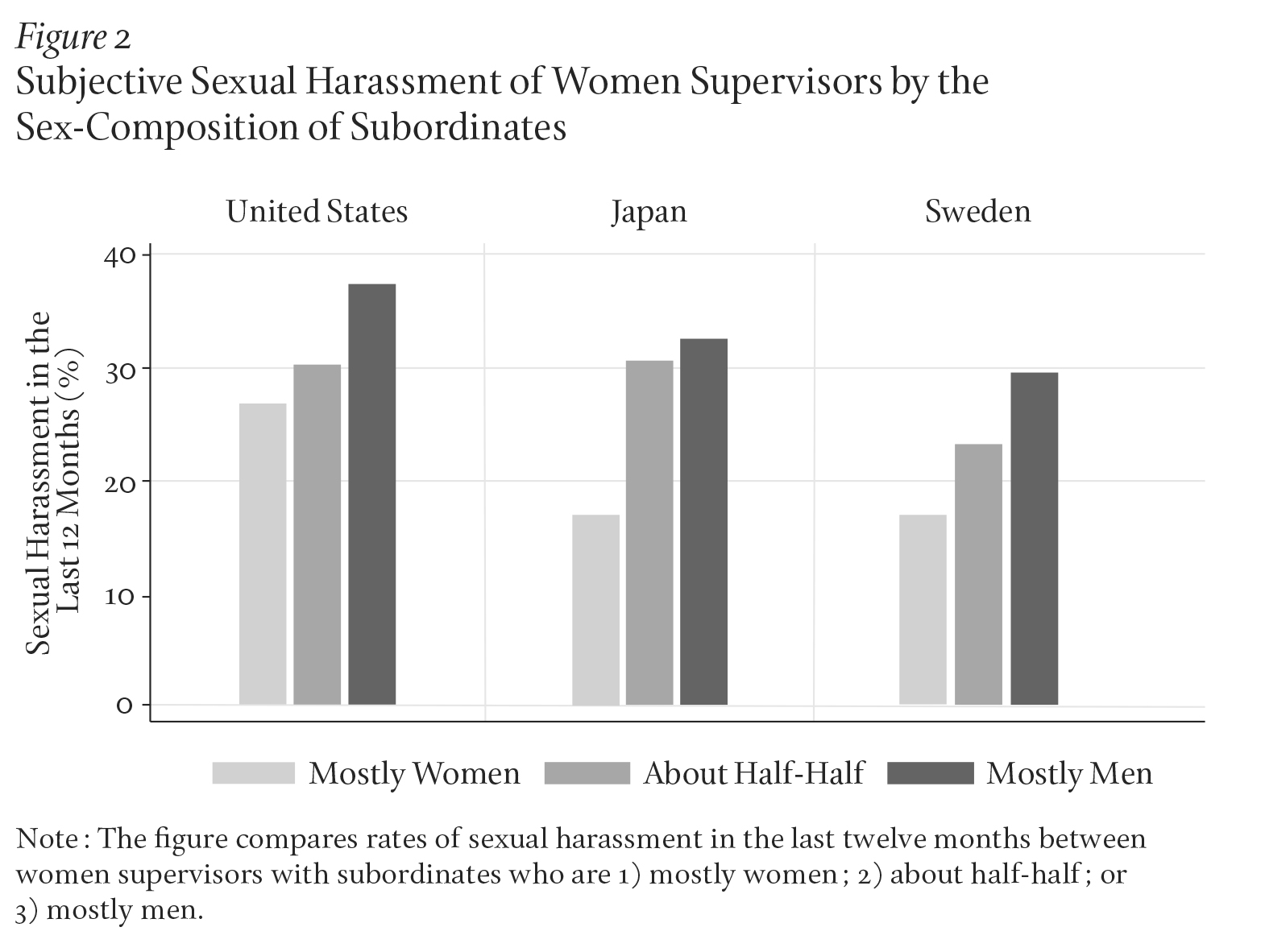
It is also possible that male subordinates are particularly sensitive to women’s leadership. In free-text responses in our Japanese survey, several respondents volunteered that women managers could be expected to experience sexual harassment out of jealousy. For example, one woman wrote that she “cannot escape from sexual harassment because male workers feel jealous about her supervisory position.” This mechanism of jealousy from employees toward women supervisors was also mentioned during the interviews at the Japanese firm.
Another way to interpret the result is that male-dominated workplaces are more likely in male-stereotyped industries such as information technology, construction, or finance. Women leaders in these sectors may trigger more hostile behavior from subordinates by being viewed, more or less consciously, as a threat to male identity.15 Sexual harassment may even become a way of gaining or equalizing power with those women.16 A telling example of a hostile dynamic appears in sociologist Heather McLaughlin and colleagues’ interviews with women supervisors. Marie, a project manager at a construction site, linked her experiences of sexual harassment to skepticism about her ability to supervise, being told that “this isn’t the job for a woman.” She concluded that in the construction business, “just being a female in management is difficult, and guys don’t like it–especially the guys that work in the field.”17
Our results suggest that power in the workplace does not protect women from sexual harassment. But how high up in the hierarchy does this problem go? In Figure 3, we subdivide women supervisors by their specific position, starting with team leaders and ending with the highest executive level. This hierarchy was defined with the same categories in the U.S. and Japanese surveys. The comparison of harassment rates is restricted to the list-based measure (Table 1), but the general pattern does not differ across the list-based and subjective measurements.
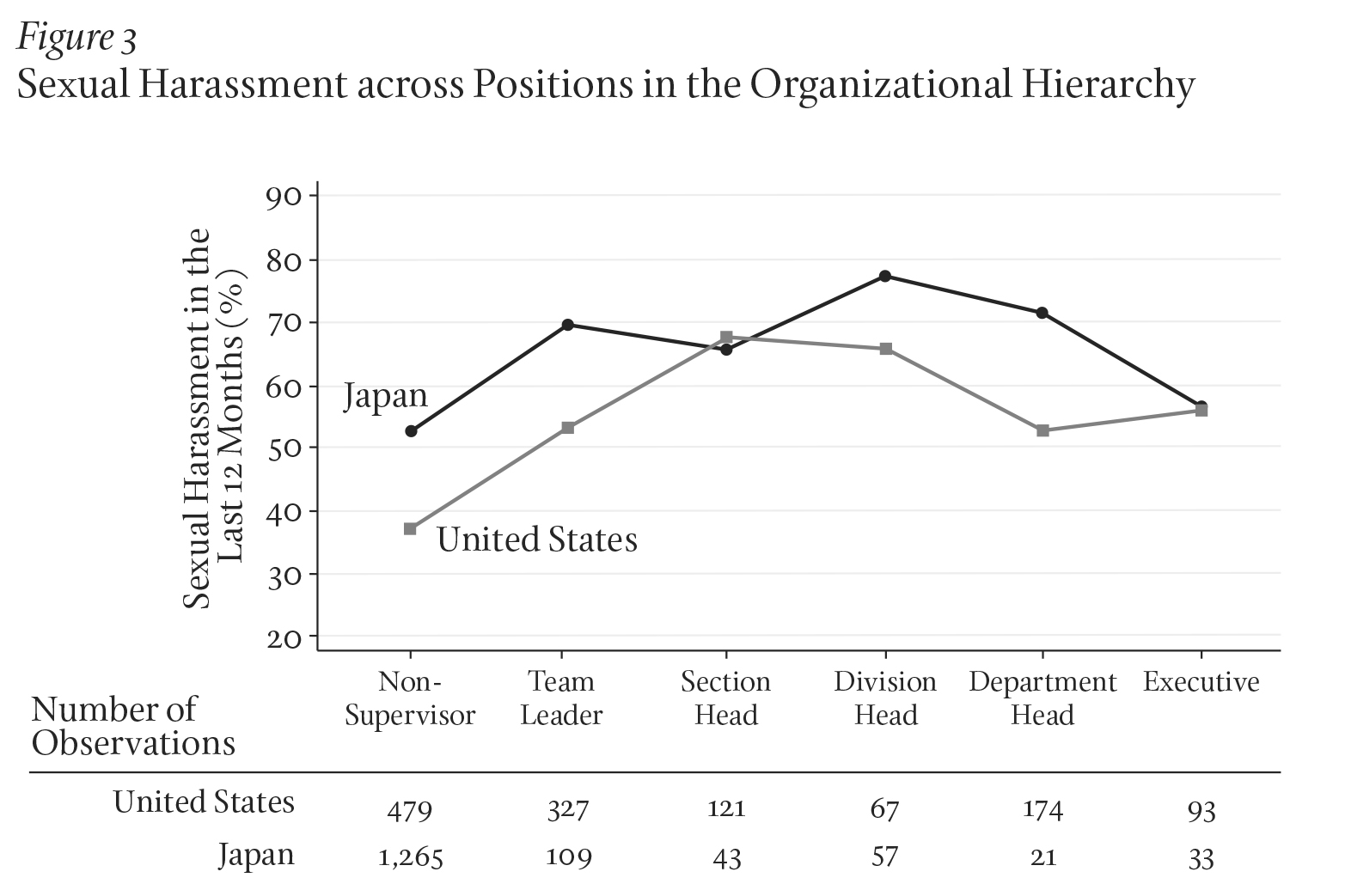
Compared with employees, sexual harassment is dramatically higher at lower levels of leadership, but the rate drops back down as we move up to the highest leadership levels. In Japan, the harassment rate for the highest executives is not higher than for employees without any supervisory role, although the extremely small number of executives in the sample makes this comparison somewhat unreliable. In the United States, the harassment rate is lower for the top two positions than for the lower levels of leadership, but is still higher than for women employees. The reverse U-shapes for both countries show that women in low- and mid-level leadership positions face the highest harassment rates. These are, of course, the women who are on the career track to top positions in the future.
Several additional aspects of these patterns are worthy of discussion. First, we find that women supervisors are not subject to fewer episodes of harassment (see the Web Appendix Table W3). Reports of high-frequency harassment are rare, but are in fact more common among supervisors than nonsupervisors.
Second, we might wonder about the role that a woman’s age plays in the relationship between leadership and harassment. Comparing supervisors and nonsupervisors of the same age shows a larger gap because younger women are more likely to be the target of harassment and, simultaneously, less likely to be supervisors. Controlling for age, the level of harassment of supervisors is striking.
Third, perhaps the most relevant critique of our analysis so far might be that supervisors are more likely than others to describe events that happened to them as “sexual harassment,” and/or to recall such events. Supervisors could be more aware of harassment because of education or status, or because they themselves are responsible for workplace policies to eradicate harassment.18 If these differences exist, the gap in harassment exposure that we find between supervisors and employees could reflect perceptions rather than actual experiences.
In the United States, the nonsupervisors were, if anything, more likely to define behaviors as sexual harassment when we asked respondents whether or not they considered four of the items on the Sexual Experiences Questionnaire to be “sexual harassment.” A slightly smaller proportion of supervisors said that they would “definitely” or “probably” define the behavior of “repeatedly telling sexual stories or offensive jokes” as harassment (76 versus 81 percent). Very similar rates were also recorded for “treating others differently because of their sex” (66 versus 64 percent) and for “staring, leering or ogling another person in a way that make them feel uncomfortable” (80 versus 83 percent). A high but slightly lower proportion of supervisors (80 versus 86 percent) said that “Making another person feel threatened with some sort of retaliation for not being sexually cooperative” was “probably” or “definitely” sexual harassment.
Why do women supervisors experience more sexual harassment? Sexual harassment is sometimes about sexual desire, but other times may be about status equalization. Consciously or subconsciously, the harasser may want to “put women in their place.” For example, laboratory studies have shown that men are more likely to harass feminist than feminine women.19 Such negative treatment of women supervisors could be linked to a distaste for female supervision.20 This distaste could also grow out of unconscious bias about appropriate behaviors and social roles for women and men. Leadership is generally considered a male activity, making a man the prototypical manager and a woman manager a deviation from the norm. Negative reactions that stem precisely from this type of norm deviation are a fundamental part of theory in sociology and economics about how social norms are maintained. Retaliation against people who break norms, such as women leaders, helps strengthen the perpetrator’s sense of self and creates a cost for breaking social norms.21
Notably, women supervisors may also need to break gender norms to carry out their jobs. Assertive and dominant behaviors commonly associated with leadership may clash with the stereotypical perceptions of what women are or should be like. Numerous studies have found that women who act in such agentic ways are perceived as unlikeable.22 Animosity toward women who take charge and delegate work motivate higher rates of harassment against them.
Do supervisors have different exposure to groups of potential harassers? When a woman is promoted from employee to supervisor, her work environment is likely to change in ways that put her at greater risk of sexual harassment. Supervisors are the focal point of their subordinates, and often meet with them one-on-one. (One Japanese female senior manager mentioned that this kind of environment put her at risk of sexual harassment.) Low- or mid-level managers also tend to interface more with top-level managers of the organization. Those interactions with leaders might expose supervisors to higher-status men who can take advantage of their relatively junior position (following the intuition of Catharine MacKinnon).23
Previous research on women supervisors also highlight the vulnerable situations with high-level men that can form outside of the office.24 Holly, the manager of a manufacturing firm, described harassment at a company dinner. As a client grabbed her leg and tried to unhook her bra at the table, none of her (male) coworkers–who noticed the obvious harassment–acted to stop it. Holly held up the male-dominance among subordinates and clients as an underlying factor that allowed the harassment to take place and hindered intervention, pointing out that “I was the only girl there. There were no other girls.”25 This type of sexualization of women who are alone in their workplace roles is known as sex-role spillover.26 For women who are alone in male groups, their female sex risks becoming their most salient and distinctive feature. They are viewed as a woman first and a professional colleague second.27 According to this logic, the power of a woman manager does not offer an escape, exposing her to harassment at male-dominated events.
Our data show that women employees and supervisors are harassed to some degree by different types of perpetrators, in ways that support our intuitions about the work environment. For respondents in the United States and Japan, those who answered affirmatively to any item on the Sexual Experiences Questionnaire were asked, in turn, to recall which incidents formed part of the most “significant event” in the last year. For this significant event, they were asked to check boxes indicating the identity of the perpetrator(s), allowing multiple answers. These responses are summarized in the top panel (A) of Table 2. In the bottom panel, we further restrict the sample to include only women who were subjected to sexual harassment.
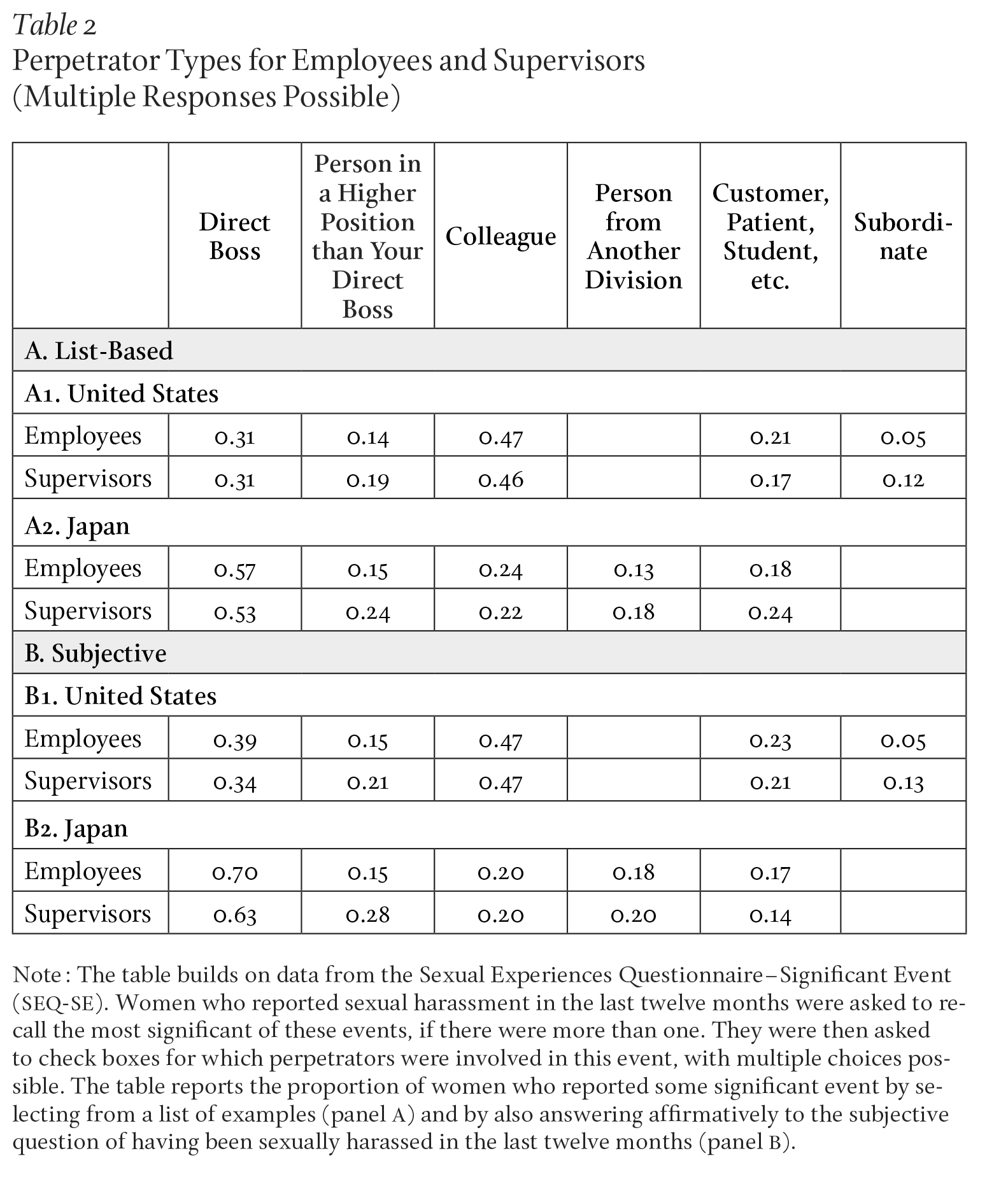
In both countries, supervisors stand out as being harassed more by “a person in a higher position than your direct boss.” This perpetrator group is 25 to 40 percent more common among supervisors than among employees in the United States, and 60 to 85 percent more common among supervisors than employees in Japan. Another difference, which can only be detected in the U.S. survey due to the structure of the survey, is harassment from subordinates. Supervisors were more likely to be harassed by subordinates, but less likely than employees to be harassed by colleagues at the same level. The difference in perpetrator groups–with supervisors being harassed more by subordinates and higher-up managers–supports the theory that moving into a position of leadership means exposure to different types of perpetrators in the workplace.
Women supervisors may, paradoxically, be less likely to formally complain about sexual harassment, which could embolden potential perpetrators. This follows the intuition that a person with a latent propensity to harass will do so if the risk of punishment is sufficiently small. Harassing a female supervisor would seem irrational if she can directly punish the assailant herself or readily access the internal complaint procedure within the firm. But using these tools may come at a greater cost for women supervisors. Women supervisors may have more to lose, both in workplace status and in the legitimacy of their leadership. Having already invested more time in climbing the career ladder in the organization, women leaders could risk more career and status losses from reporting an incident compared with women employees.
Our surveys in the United States and Japan asked women to report which actions they took after being sexually harassed. Female supervisors, we found, were slightly more likely to take action than female workers in Japan, and decidedly more likely to act in the U.S. case. Japanese women supervisors were as likely or less likely to report to their boss or to a consultancy service within the firm (6 versus 7 percent for list-based reporting, but 6 versus 14 percent using subjective reporting). They were, however, about twice as likely to report to an agency outside the firm, where options in the survey included a labor union, a bureau of labor, a company that dispatched the worker, the police, a lawyer, the municipality, or a nonprofit organization. Among supervisors, 27 percent reported the harassment to an entity outside the firm in the case of list-based sexual harassment, and 13 percent for subjective harassment.
U.S. supervisors were more likely than employees to take all three types of action: issue a personal protest, report within the organization, and report outside the organization. Eighteen to 20 percent of supervisors who reported harassment took personal action compared with approximately 14 percent of employees. Nearly one-third of the supervisors took action within the firm, compared with 12 to 20 percent of employees. Outside help was sought by 13 to 21 percent of supervisors, compared with just 5 to 8 percent of employees. In sum, there is no evidence that women supervisors would be more attractive targets of harassment by being less likely to take action, either personally or using actors inside or outside the workplace.
So far, we have shown that despite having more power in the workplace to take action when they face sexual harassment, Japanese supervisors are not more likely to do so than employees. We conducted a survey experiment to shed light on a possible reason for this. The experiment targeted third-party advice to report sexual harassment within organizations. By using conjoint experimental methods, respondents were asked if they would recommend that certain women, described by a list of traits, should seek organizational assistance. The methods allow us to causally isolate the impact of women’s supervisory status relative to employee (nonsupervisory) status on third-party advice to report. Japanese respondents reacted to the trait of a woman victim’s supervisory status by becoming 7.2 percentage points less likely to advise her to seek assistance (standard error = 0.02). U.S. respondents, in contrast, did not differentiate between supervisors and employees in this regard. These results are described in the Web Appendix section called Conjoint Analysis. They suggest that more negative attitudes among bystanders toward women supervisors’ reporting of harassment in Japan could be a reason for the relative inaction of these women supervisors.
Japanese survey respondents explained in free-text answers why they recommended women supervisors not to seek organizational assistance. Among three hundred such answers, a common theme was that seeking assistance would be viewed as a managerial failure on the part of the victim. Responses included, for example, that “A female supervisor who reports an incident will be viewed as having low capabilities for being unable to avoid or manage the harassment” and, similarly, that “She could have avoided the harassment in advance if she is in a supervisor position.”
In a final set of empirical results, we turn our attention to the consequences of sexual harassment and whether these consequences differ between supervisors and employees. Our surveys in the United States and Japan contain two questions on consequences. These were divided into two types–social and professional–following on the work of psychologists Vicki Magley and Lilia Cortina.28 Professional consequences are tangible, formal, and possible to document in employment records, and might include discharge, involuntary transfers, demotions, poor performance appraisals, or deprivation of perquisites or overtime opportunities. Social consequences that often go undocumented may include name-calling, ostracism, blame, threats, the “silent treatment,” or additional sexual harassment.
Respondents were given a list of professional and social consequences and asked to report which of the situations applied after their significant event of sexual harassment. We plot the difference in the proportion of supervisors and employees that reported each consequence in Figure 4. The whiskers around each difference denote a 95 percent confidence interval for the difference in proportions.
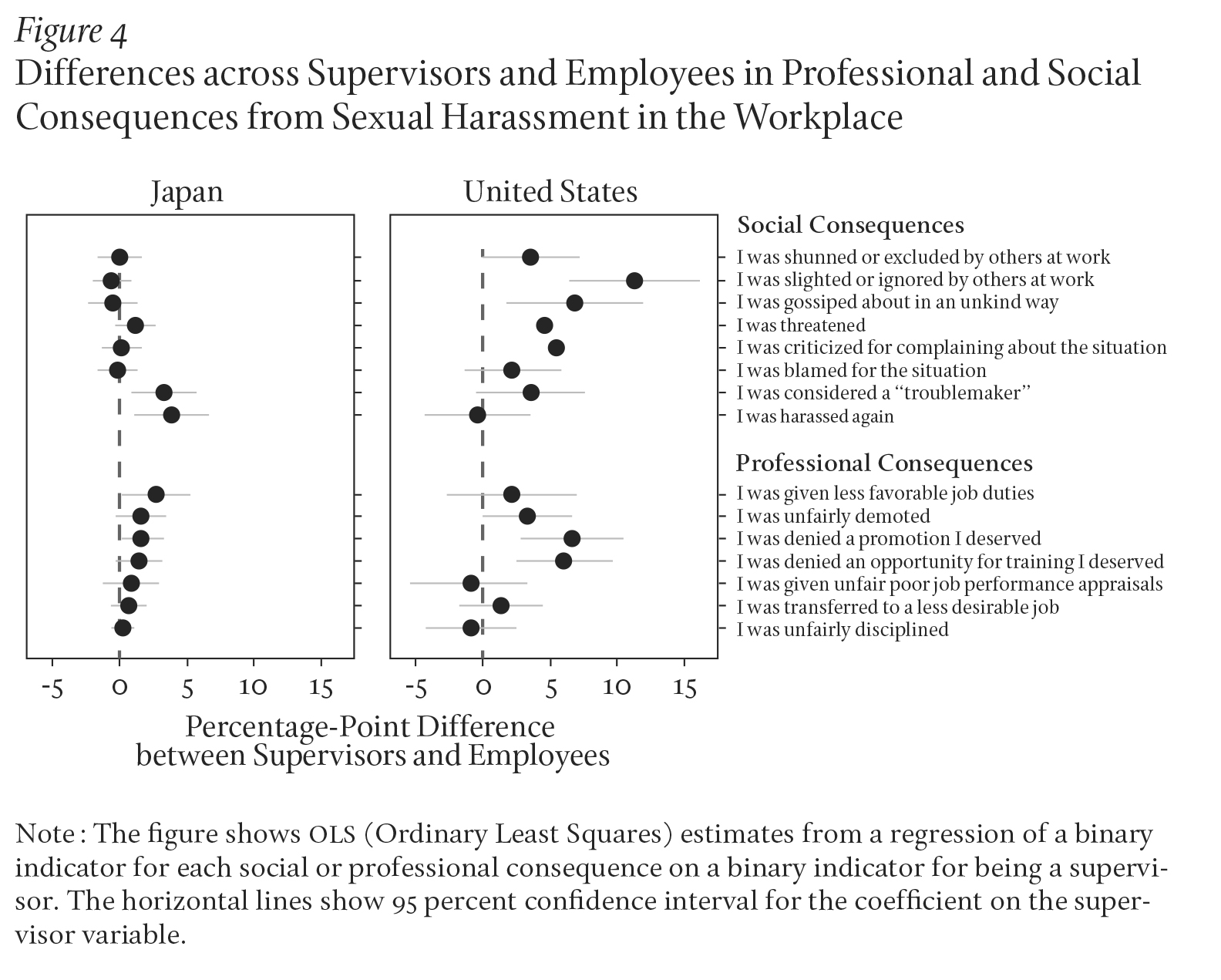
There are two main takeaways from the analysis. First, supervisors face more, not fewer, negative consequences of being sexually harassed. One reason for this could be the pattern we uncovered of who harasses: higher-level managers are more likely to be the perpetrators. Another reason might be that supervisors are more likely to take action against their harassers, which could trigger the retaliation against them. The fact that U.S. women, and U.S. supervisors in particular, were more likely to take action could perhaps explain the differences between the United States and Japan. In both countries, however, women who reported their harassment faced negative consequences.
In Japan, two consequences stand out: 1) more harassment, and 2) a greater risk of being labeled as “troublemakers” in the organization. Demotions and less favorable job duties are also more severe for supervisors, although the point estimates are not very large. In the United States, supervisors are more likely to be affected by the full range of social consequences, as well as denials of promotions or training. These results suggest that in both countries, supervisors have more to lose from sexual harassment.
Sexual harassment is a severe workplace problem. Roughly half of all women can expect to experience it at some point in their work lives.29 This prevalence of harassment has been highlighted by the large #MeToo movement and the numerous reports and convictions of sexual harassment that followed.30
Our evidence refutes the idea that workplace power insulates women from sexual harassment. To the contrary, power is associated with more harassment, at least for women climbing the ladder toward higher positions of leadership. One reason for this pattern could be that workplace power exposes women to different groups of potential harassers. Supervisors are the focal point of subordinates and also have more interactions with higher-ups in the organization. We do not find, moreover, that supervisors are less likely to report harassment. Supervisors are at least as likely as employees to confront the harasser, to report within the organization, or to report to an outside actor. Perhaps it is precisely because they are more likely to report that supervisors face more negative professional and social consequences following incidents of harassment.
Women’s continued advancement to leadership roles in the labor market is a necessary pathway to economic equality between men and women. It is also a prerequisite to make good use of human capital and to maximize economic efficiency.31 Our analysis strengthens the insight from previous research that sexual harassment is a serious impediment to increased gender equality.32 Sexual harassment disincentivizes women to take leadership positions in the workplace, on top of the many other impediments standing in women’s way outlined in this volume: norms that prohibit long work hours, friction in family life, and perceptions of unlikability when women act in agentic ways.33 It is vital that we grasp the extent to which sexual harassment deters women from seeking leadership roles.
